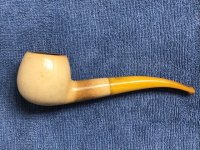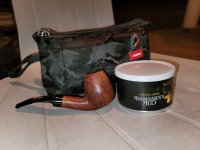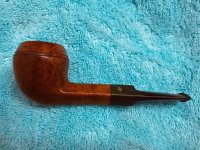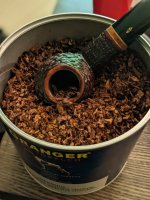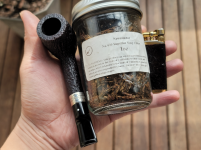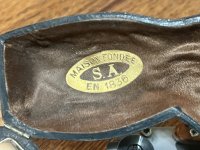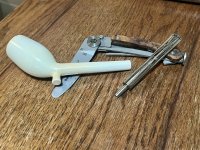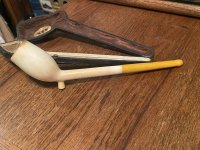***What Are You Smoking, November 2022?***
- Thread starter JimInks
- Start date
You are using an out of date browser. It may not display this or other websites correctly.
You should upgrade or use an alternative browser.
You should upgrade or use an alternative browser.
SmokingPipes.com Updates
Watch for Updates Twice a Week
- Status
- Not open for further replies.

More evil tobacco in a Bullmoose second generation five pointed three star Lee. It’s a Beast of a tobacco. Thanks to @fightnhampster . Only issues I have with it are with being a follower of Christ. Not sure how to reconcile this.
GH&Co. Scotch Mixture in a MM and C&D collaborative cob straight nose warmer with a tomato red stem. Planning a Thanksgiving with friends from church, a scaled down feast with good conversation and a new cat to meet. Tonight just paying some bills and getting down ingredients for my wife to make some rolls to take to Thanksgiving. Among my long list of things to be thankful for will be the good people on Forums. Happy Thanksgiving to all, those who celebrate this holiday and everyone else as well.
1Q in a Kaywoodie 93b. Haven't smoked this blend or pipe in well over a year. There's something about the weather this time of year that makes this blend extra delicious.
Golden Triangle Paulina in an Altinay translucent meerschaum billiard
Wrap it with the paper in the package, and then place it in the pottery pot. Cover it without sealing, but do not put it together with other smelly things (especially tobacco). Do not use porcelain pot or mason jar. It should be placed in a place where the air can circulate but there is no direct sunlight. The air humidity should not exceed 75%. It should be checked every six months.i really had no idea what all this pu'erh tea talk was all about, then remembered a box of tea a friend gave us a few years ago after returning from a trip to china. Turns out we have some! Now what do i need to do to store it correctly!?
View attachment 182958
Sorry to cause a crisis of faithView attachment 183044
More evil tobacco in a Bullmoose second generation five pointed three star Lee. It’s a Beast of a tobacco. Thanks to @fightnhampster . Only issues I have with it are with being a follower of Christ. Not sure how to reconcile this.
we call that: 洗茶 wash tea.I also read about it just right now. Especially on how the Chinese use to prepare that kind of tea. They wash it for a few seconds with the first gush of hot water, and pour that first brew away, then drinking the second, third…brewed with fresh water.
Pu'er tea exists because the compressed tea is convenient for international transportation. Before the 20th century, most Chinese people did not like this kind of tea. Since the 5th century AD, the nomads on the Mongolian Plateau mainly consumed Pu'er tea. They smashed the tea bricks with a hammer and boiled it with milk. They usually used horses and other products to exchange tea as a vitamin supplement.
Pu'er tea belongs to big leaf trees. We (the Han people in the plain area, more than 93% of the Chinese population) prefer black tea and green tea with small leaf shrubs as raw materials, as well as some semi fermented tea. The price of Hi-End products is very scary (10000usd/100g). For us, Pu'er tea or other tea bricks are cheap foreign trade products. This view did not change until decades ago.
Not only Yunnan, but also central China also produces tea bricks similar to Pu'er. In a small town more than 2 hours drive from Wuhan, I once saw a quite expensive old tea brick, which was customized from China shortly after Twinings was founded. At that time, the British had not introduced tea to India. That factory is still producing. Twinings Company customized 2000 tea bricks from this factory for the 200th anniversary celebration in 1981.
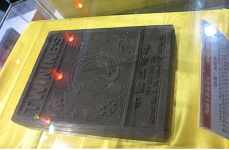
Smoked some 5-year-old Hal o' the Wynd in my brand new (to me) estate smooth Savinelli Punto Oro Gold (701) lovat with a vulcanite stem. Packed this on Saturday. I've gotten in the habit of packing a few pipes and leaving them inside my jacket pocket in case the opportunity strikes. This is my first bowl in this pipe. Seems like a great smoker and this tobacco is tasting SUPERB. Fine white ash. You know the rest. I'm more of an Old Gowrie kind of guy, but this HOTW is tasting amazing now at 5 years. They didn't lie.
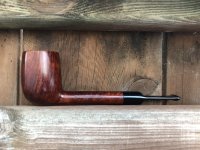

- Status
- Not open for further replies.





